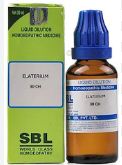Elaterium Officinarum: A Deep Dive into the Homeopathic Remedy for Scurvy, Diarrhoea, and Beyond
Homeopathy is a fascinating world where nature’s remedies are harnessed to heal the body and mind. Among the lesser-known but highly potent remedies is Elaterium Officinarum, derived from the Squirting Cucumber (Ecballium elaterium or Momordica elaterium). This Mediterranean plant, belonging to the Cucurbitaceae family, has a unique signature and a powerful effect on the human body, particularly the gastrointestinal tract. Let’s explore this remedy in detail, its uses, and its profound healing potential.
The Signature of Elaterium: Nature’s Clue
The signature of Elaterium is as striking as it is symbolic. The ripe fruit of the Squirting Cucumber explodes, scattering its seeds with force. This explosive action mirrors the remedy’s key symptom: profuse, gushing diarrhoea. Just as the seeds are expelled violently, the stool is watery, copious, and forceful, often described as olive-green and frothy. This vivid imagery makes Elaterium’s application in homeopathy “too obvious to be missed.”
Key Indications and Uses
Elaterium is primarily known for its action on the gastrointestinal tract and mucous membranes. Its ability to drain watery fluids from tissues makes it a valuable remedy for conditions like diarrhoea, dropsy, and even scurvy. Here are some of its most notable uses:
- Scurvy and Diarrhoea
Elaterium is a standout remedy for scurvy, particularly when accompanied by gushing diarrhoea. It also addresses beriberi, another scurvy-related condition. The remedy’s ability to strip the intestinal membrane of its epithelium highlights its intense action on the gut. - Gastrointestinal Disorders
- Violent purging: Profuse, watery, olive-green, bilious stools.
- Vomiting: Excessive gastric secretions.
- Colic and griping pains: Cutting pains in the bowels, retracted abdomen, and rumbling flatus.
- Dysentery: Painful, watery stools with soreness of the anus.
- Dropsy and Fluid Retention
Elaterium’s ability to drain fluids makes it effective in treating dropsy (edema) and other conditions involving fluid retention. Minute doses can promote the absorption of excess fluids in the body. - Fever and Cholera
- Yawning and gaping: Marked symptoms before a chill, especially in cholera or intermittent fever.
- Cholera-like symptoms: Copious evacuations and dehydration.
- Skin and Abscesses
Elaterium promotes the opening of abscesses and boils, aiding in the healing process. It is also useful for urticaria (nettle rash) caused by suppressed intermittent fever. - Rheumatic and Neuralgic Pains
- Sciatica: Shooting or dull aching pains along the sciatic nerve.
- Gouty pains: Especially in the great toes.
- Arthritic nodules: Pain in hip joints, fingers, and thumbs.
Mental and Emotional Symptoms
Elaterium also has a unique impact on the mind. It is indicated for:
- Irresistible desire to wander from home at night.
- Mental disorders arising from suppressed malaria or other chronic conditions.
Modalities: When is Elaterium Indicated?
- Worse: Damp weather, standing on damp ground.
- Better: Open air, dry conditions.
Clinical Applications
Elaterium’s wide range of applications includes:
- Abscesses, boils, and skin eruptions.
- Bilious fever, jaundice, and liver disorders.
- Measles, erysipelas, and nettle rash.
- Neuralgias, rheumatism, and sciatica.
Comparison with Other Remedies
- Bryonia: Colic and sciatica.
- Veratrum album: Neuralgia and choleric affections.
- Colchicum, Crotalus t., Veratrum: Cholera-like symptoms.
- Secale: Olive-green diarrhoea.
- Cantharis: Dysenteric diarrhoea with painful urination.
- Apis, Hepar sulph, Ignatia, Rhus tox: Urticaria during intermittent fever.
Dosage and Administration
Elaterium is typically administered in tincture form (from the unripe fruit) or as a trituration of Elaterinum. The potency and dosage should be determined by a qualified homeopath based on the individual’s symptoms and constitution.
Conclusion
Elaterium Officinarum is a powerful homeopathic remedy with a unique signature and a broad spectrum of applications. From its explosive action on the gastrointestinal tract to its ability to drain fluids and alleviate rheumatic pains, this remedy is a testament to the profound healing potential of nature. Whether you’re dealing with scurvy, diarrhoea, dropsy, or even mental unrest, Elaterium may hold the key to restoring balance and health.
As with all homeopathic remedies, it’s essential to consult a trained homeopath for proper diagnosis and treatment. Nature’s wisdom, when harnessed correctly, can work wonders for the body and soul.
References:
- Allen, T.F. – Encyclopedia of Pure Materia Medica.
- Boericke, W. – Pocket Manual of Homeopathic Materia Medica.
- Boger, C.M. – Synoptic Key.
- Clarke, J.H. – A Dictionary of Practical Materia Medica.
- Cowperthwaite, A.C. – Textbook of Homeopathic Materia Medica.
- Hughes, R. – A Cyclopedia of Drug Pathogenesis.
- Murphy, R. – Lotus Materia Medica.
- Phatak, S.R. – Homeopathic Materia Medica.
- Pierce, W.I. – Plain Talks on Materia Medica with Comparisons.
Disclaimer: This blog post is for informational purposes only and should not replace professional medical advice. Always consult a qualified homeopath or healthcare provider for personalized treatment.


